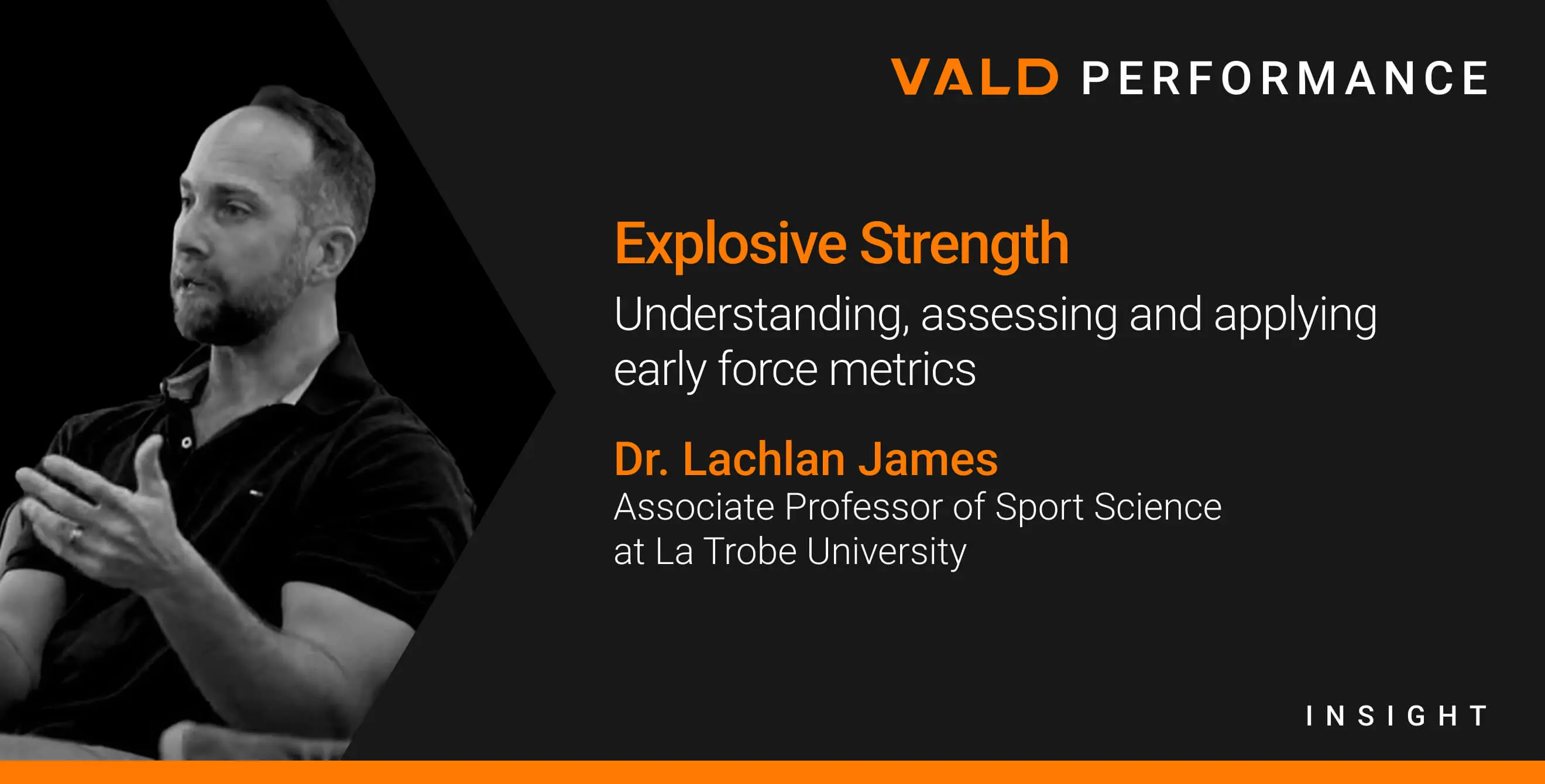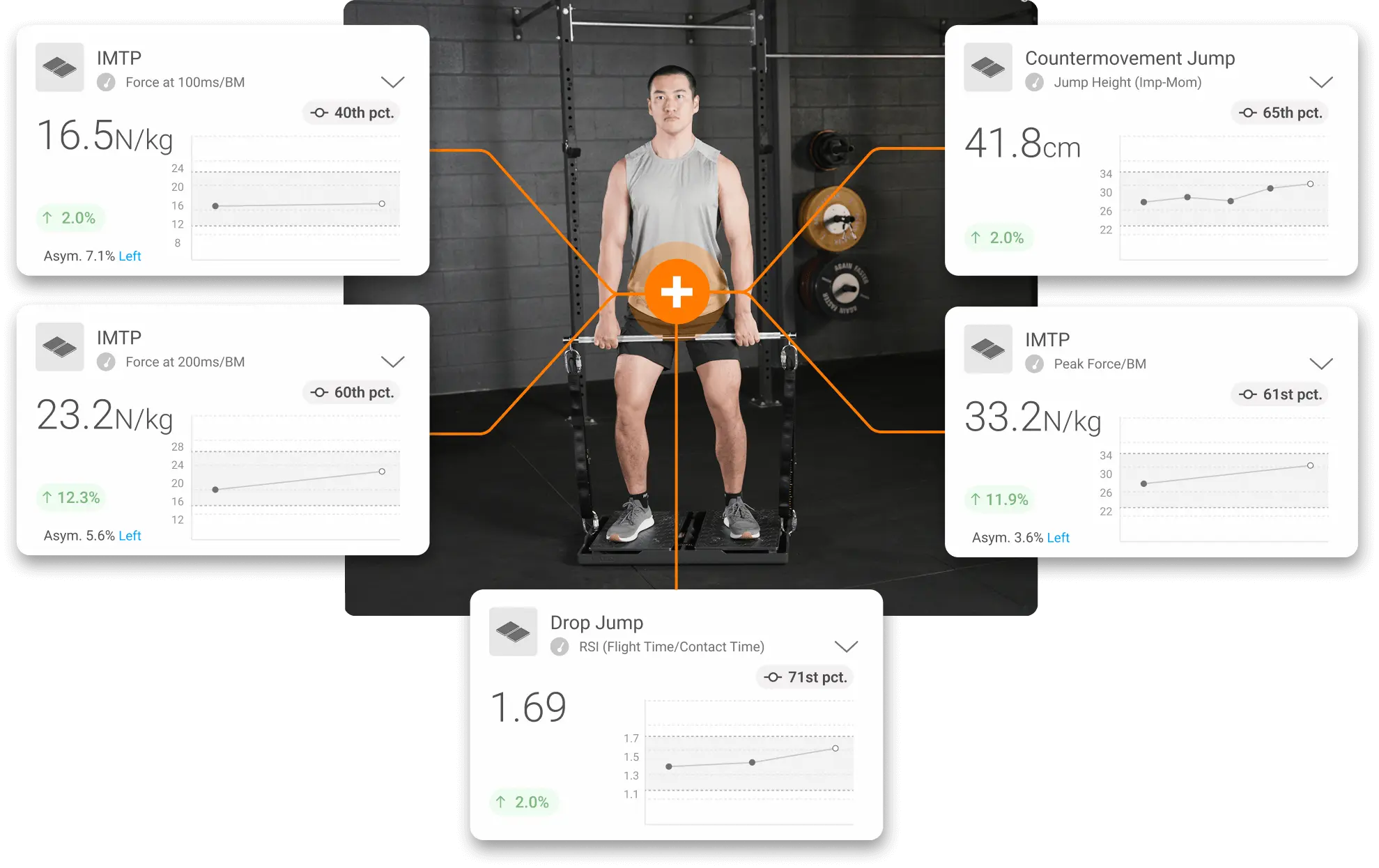Explosive Strength: Understanding, assessing and applying early force metrics
Available in:
EN
About the Author
Lachlan James, PhD, is an associate professor of sport science at La Trobe University and the founder of ForceLab Strength Science Solutions. With over 60 peer-reviewed publications, his research focuses on strength science, particularly strength diagnostics and training adaptations.
He currently supervises nine PhD students and oversees strength science projects across AFL and NRL clubs, as well as at institutes of sport, including the Queensland Academy of Sport and the Victorian Institute of Sport.
What Is Explosive Strength?
Explosive strength describes the capacity to generate high levels of force in the very early stages of muscular contraction against load, typically within the first 50-150 milliseconds (ms), without assistance from the stretch-shortening cycle (SSC). This quality reflects how effectively an athlete can initiate force production in the absence of a preceding eccentric action.
In practice, explosive strength is commonly assessed through isometric tasks such as the isometric mid-thigh pull (IMTP) or isometric squat (Iso Squat), with analysis focused on the earliest portions of the force-time curve. Although explosive strength can be measured in isolated joint functions (e.g., using handheld dynamometers (HHDs) such as DynaMo or fixed-frame dynamometers (FFDs) such as ForceFrame), it is often used in upright, multi-joint assessments on force plates, such as ForceDecks.
Athlete performing a Run-Specific Ankle Iso-Push, a common explosive strength assessment for sprinters.
The term “explosive strength” conveys the essence of this strength quality, is widely used in practice and appears throughout seminal scientific literature.
Although rate of force development (RFD) is often used synonymously with explosive strength, this can be misleading. RFD is a calculated quantity derived from any measure that includes force and time. Because of this, it can represent multiple underlying qualities, making interpretation highly context-dependent and often misunderstood.
RFD can also be calculated in dynamic, SSC-based actions, yet these forms of expression overlap little with isometric explosive measures.
…explosive strength is best viewed as the isometric expression of rapid force production, representing a quality that remains statistically independent from [other forms of]…strength.
For clarity, explosive strength is best viewed as the isometric expression of rapid force production, representing a quality that remains statistically independent from maximal strength and speed strength.
How Is Explosive Strength Measured?
Several quantities that can be used to capture explosive strength, including the following:
- Instantaneous force outputs (e.g., force at 100ms)
- RFD (e.g., RFD at 100ms)
- Impulse, calculated as the force-time integral across a time window (e.g., 0-150ms)
Each of these measures can be calculated at any point within the early portion of the force-time curve, typically 150ms or less.
Each of these measures can be calculated at any point within the early portion of the force-time curve, typically 150ms or less.
The time window of analysis is crucial for explosive strength measurement. If force is sampled too late, values begin to converge with measures of maximal isometric strength. For example:
| Metric | Shared Overlap with Peak Isometric Force |
| Force at 250ms | 76% |
| Force at 150ms | 50% |
| Force at 50ms | 37% |
Taken from James et al. (2022).
This table demonstrates that earlier time windows diverge from measuring the same construct as maximal strength.
Isometric force-time curve depicting different sampling windows for explosive strength measurement.
Challenges with Explosive Strength
Despite their value, explosive strength metrics carry reliability challenges. Outcomes are influenced by the athlete’s effort, cueing, pretension and post-hoc analysis decisions. As such, proper familiarization, clear instructions, consistent cueing and informed trial selection are essential. The following recommendations assume that practitioners are using validated measurement technologies, such as ForceDecks.
| Challenge | Outcome | Solution |
| Athlete Effort | Variable athlete effort (e.g., not providing maximal effort on all repetitions or occasions) will lead to highly variable results. | Cue the athlete for maximum effort and intent with each execution. Use biofeedback based on trial results and ensure they are assessed in the same state (fresh or fatigued) each time. |
| Cueing | Cueing “push” or “pull hard” without emphasizing “fast” can influence data quality. | Cue the athlete to “push or pull as hard and as fast as you can.” |
| Pretension |
Without pretension (<50N of force before execution), start of movement detection may be affected, altering time windows for sampling.
With excessive pretension (>100N), the validity of the test is affected due to substantial force being produced prior to onset. | Instruct the athlete to “stiffen up without too much effort” and hold for 2-3 seconds before executing the test. Use a live force-time trace to visualize small pretension prior to execution. |
| Post-Hoc Analysis Decisions | Incorrect trial selection methods have a meaningful impact on reliability. | Select trials based on best early force, rather than peak force, to improve the reliability of explosive strength measures while retaining maximal strength reliability. |
When implemented correctly, explosive strength testing offers a valuable lens into an athlete’s neuromuscular function that aligns with many aspects of sports performance. It also adds context to a broader strength assessment battery by capturing qualities not reflected in other measures.
…explosive strength testing offers a valuable lens into an athlete’s neuromuscular function…[and captures] qualities not reflected in other measures.
Case Example
An athlete was assessed on ForceDecks using the IMTP, countermovement jump (CMJ) and drop jump (DJ). For the isometric assessment, the athlete was instructed to “push as hard and as fast as you can.” Three trials were performed for each assessment, and the averages were visualized in VALD Hub.

Test results from an athlete profiling session.
| Test | Metric | Result |
Percentile (Norms) |
| IMTP | Force at 100ms / body mass (BM) | 16.5N/kg | 40th |
| Force at 200ms / BM | 23.2N/kg | 60th | |
| Peak force / BM | 33.2N/kg | 61st | |
| CMJ | Jump height | 41.8cm | 65th |
| DJ | Reactive strength index | 1.69 | 71st |
In this example, the athlete is benchmarked similarly for force at 200ms / BM and peak force / BM, showing strong convergence in the underlying quality that both metrics capture. This alignment is consistent in the literature, where force at 200ms shares 60% variance with peak isometric force (James et al., 2022).
Force at 100ms provides additional value by revealing an attribute, and in this case, a weakness, that is not captured by later measures.
Force at 100ms provides additional value by revealing an attribute, and in this case, a weakness, that is not captured by later measures. This athlete shows a relative weakness in explosive strength measures (40th percentile for force at 100ms / BM), compared to late and peak isometric force.
Since force at 100ms and peak force share between 20 and 30% variance, this deficit may be partially masked by the athlete’s above-average peak force, meaning their true early-phase output could be even lower, if not for their above-average peak force.
Jump metrics provide useful context. Although ballistic tasks are often linked to early isometric force, they rely on different mechanisms. Producing force rapidly against load without SSC involvement is distinct from success in high-velocity, SSC-driven movements.
Training Intervention
Developing explosive strength requires exercises that train rapid force production under load, without relying on the SSC. Weightlifting derivatives are ideal for this, allowing athletes to move heavy loads while producing high RFD, something traditional lifts or heavy jumps cannot match.
Developing explosive strength requires exercises that train rapid force production under load – without relying on the SSC.
These movements are also versatile. Adding a pause at the hang position removes the countermovement, making exercises like the clean pull or jump shrug more specific to explosive strength. Pulls from the floor offer broader transfer, while varying hang positions let you target sport-specific joint angles.
The key is matching the exercise to the athlete’s technical ability. If they cannot yet produce force quickly under load, start with simpler variations and progress as needed. Weightlifting derivatives provide a potent and flexible approach to developing explosive strength in both individual and team environments.
Take-Home Points
Explosive strength reflects rapid isometric force production, distinct from maximal strength or SSC-driven qualities. Early time point metrics (<150ms) reveal information that peak force alone cannot, while later values tend to converge with maximal output.
Strong CMJ or DJ performance does not guarantee high explosive isometric capacity, so interpretation requires context. Training should target rapid force under load, with weightlifting derivatives and isometric methods offering specific, adaptable options when aligned with the athlete’s skill level.
To learn how VALD systems can help you measure, monitor and enhance explosive strength through objective assessment and data-driven insights, get in touch with our team.
References
- James, L. P., Talpey, S. W., Young, W. B., Geneau, M. C., Newton, R. U., & Gastin, P. B. (2022). Strength classification and diagnosis: Not all strength is created equal. Strength and Conditioning Journal, 45(3), 333–341. https://doi.org/10.1519/ssc.0000000000000744
